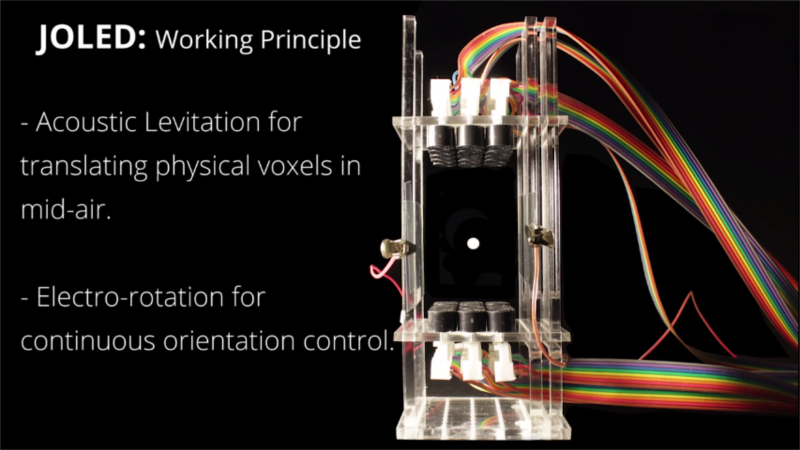Flip-Dot displays are so awesome that they’re making a comeback. But awesome is nothing when you can have an insane flip-dot display that is three-dimensional with the dots floating in mid-air. Researchers at the Universities of Sussex and Bristol have built what they call JOLED, an array of floating pixels that can be controlled via a combination of ultrasonic standing waves and an electrostatic field. These “voxels” can be individually moved in space via ultrasonics, and can also be individually flipped or rotated through any angle, via the electrostatic field.
The key to the whole thing is something they call Janus Objects – hence JOLED. Janus particles have different features or chemistry on two opposite sides. A portion of each voxel is speckled with a small amount of titanium dioxide nano powder. This gives it a bipolar charge that makes it respond to the variable electrostatic field and hence capable of axial rotation. Half of each white voxel can then be covered with a contrasting color – red, blue, black – to achieve the flip dot effect. Each voxel appears to be a couple of millimeters in diameter. The ultrasonic actuators appear to be regular piezo transmitters found in every hacker’s parts bin. Transparent glass plates on opposite sides apply the variable electrostatic field.
While this is still experimental and confined to the research lab, future applications would be interesting. It would be like breaking e-ink displays out of their flat glass confines and giving them a third dimension. The short, two-minute video after the break does a good job of explaining what’s going on, so check it out. Now, who want’s to be the first to build a JOLED clock?
Thanks to [Garrow] for tipping us off about this.
















thats impressive. i didnt know you could do that with acoustics.
I did an acoustic levitation demo for one of my IO projects.
https://www.youtube.com/watch?v=GgWMPX8J9LI&feature=youtu.be
It’s not hard to set up a standing wave reflecting off of a hard surface, and the pressure minimum will grab and hold a lightweight object. They’re system is much further along than mine, though.
what kind of speaker are you using and would a normal audible speaker work?
That’s using ultrasonic transducers … I guess you could do it at lower frequencies, but it wouldn’t be terribly efficient, and you better have your earmuffs handy.
That’s a 40 kHz ultrasonic cleaner. You can do it with speakers as long as you can set up a standing wave, but they’ll be less efficient since they’re designed to project sound omnidirectionally rather than in a straight line.
The amount of stuff you can levitate/number of voxels is also limited by the frequency. The resolution in mm is 340,000/(2*f). For 40 kHz (roughly an octave higher than human hearing), the resolution is 4.25 mm. If you tried to do this with middle C, the resolution would be 1.3 meters. You really need something above 15 kHz to do this practically/not deafen yourself, and thats a lot to ask from normal speakers.
The scope suggests you are sending in a square wave. Aside from heating up the driver how do triangle and sinusoidal waves cause this to behave?
The transducer appears as a series LRC circuit, with the LC frequency defined by the physical characteristics of the device. The maximum sound power is delivered with the driving circuit is at the resonance frequency and a sine wave of high voltage, typically a couple of hundred volts.
The circuit puts a 12V square wave into a transformer to make about 200 volts.
Triangle and square waves can be considered a sum of sines. The transducer, as LC, will pass the resonant frequency through and show a high impedance to other frequencies in the drive signal, so in effect they consume little or no power.
Also, the transformer will work as a transformer at 40 kHz, but not at 80 kHz. Effectively the transformer is a filter – the base frequency voltage is stepped up and the harmonics are suppressed. The actual output is (mostly) a sine.
Overall, waveform profile has little or no effect.
The most efficient drive is a single sine at the resonant frequency, but getting a 100 watt sine at 400 volts is tricky at the hobbyist level, so I cut some corners and used square waves. :-)
Surprised they could do it with what look like standard small transducers
3D eink? Awesome!
Wow, very interesting! I wanted to learn more and discovered that the Wikipedia article is absolutely terrible, just a stub. :/
Beat that problem gets fixed quickly.
The page on Acoustic Tweezers is much more informative.
Now, how to make an actual hoverboard with this…
I’m sure we’ll see Tetris and Flappy Birds first!
Standing waves are just weird. I realise they exist, in RF and electromagnetics, lasers and all sorts. But the idea of a wave, emitted from a point, that doesn’t actually move. Very strange!
Editors, could you please add a few tags to this article: http://hackaday.com/tag/acoustic-levitation/ and
http://hackaday.com/tag/levitation/
:)
Added